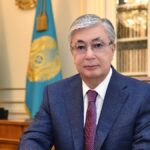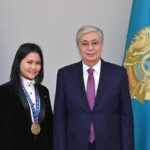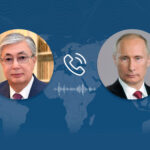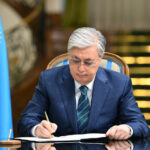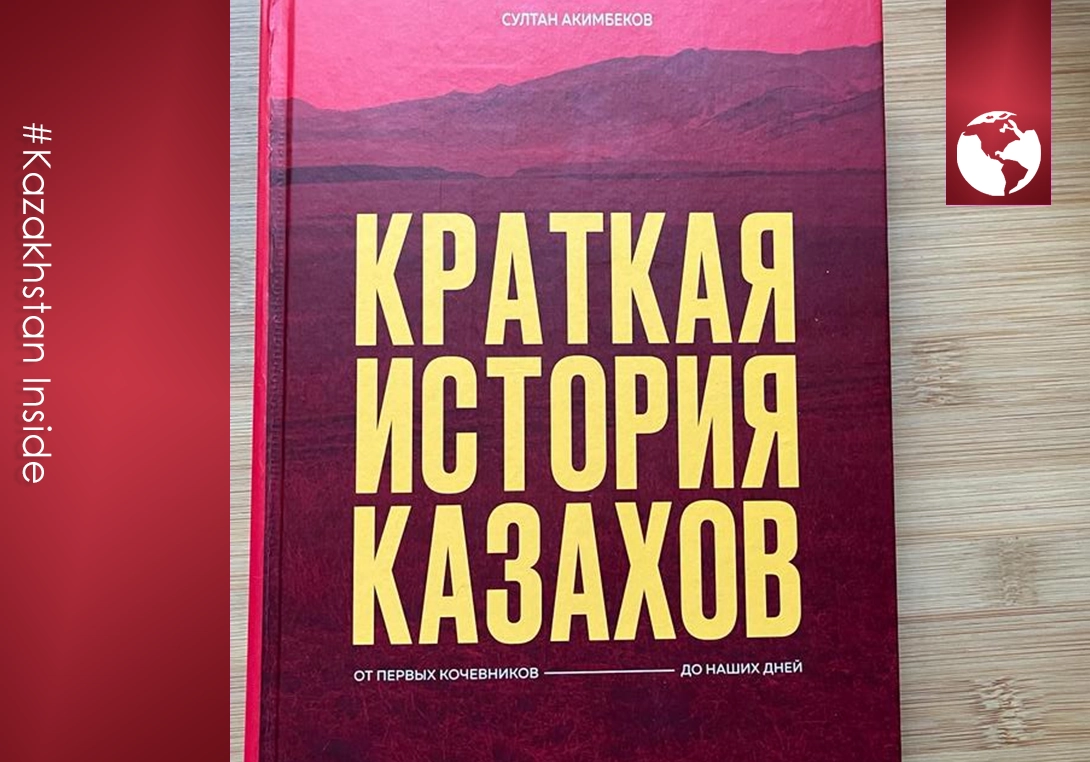At present, Kazakhstan shows voluptuous appetite to own history. Because there is the obvious deficit of proper quality history literature, there still are no univocal answers to many complicated questions.
Existing books and textbooks meticulously describe the chronological sequence of events that took place in the vast steppe territories of the Eurasian continent, but typically do not explain their internal logic and fail to answer the questions «why?» and «why exactly like this?»
In the book «A Brief History of the Kazakhs,» authored by Sultan Akimbekov, which researcher examines the history of states and peoples living in the territory of modern Kazakhstan, particularly the Kazakhs and Kazakh khanates, readers can find answers to many mysteries of the past and paradoxes of the present.
In fact, this is the first and currently the only comprehensive book on the history of the Kazakhs — from the earliest tribes who roamed the heart of Eurasia to the parliamentary elections of 2023 that took place in the «New Kazakhstan» under new rules.
Kazakh Soviet Socialist Republic (KazSSR), 1964 to 1985
With the rise to power of Leonid Brezhnev, the situation in the USSR underwent a transformation. As a result of stabilizing the position within the Soviet bureaucratic hierarchy, the character of internal relationships changed significantly. Patron-client relationships began to develop to a much greater extent than before, serving as the foundation for the organization of the entire bureaucratic system. It is clear that such relationships existed during the Soviet period, starting from the 1920s. However, the highly tense atmosphere during Joseph Stalin’s rule and the constant transformations within the bureaucracy under Nikita Khrushchev did not promote the establishment of stable patron-client networks. In particular, under Stalin, prominent figures of the party establishment often faced various forms of repression — from exile to execution. Naturally, such excesses had severe consequences for any networks, even those oriented towards key figures within the establishment.
During Khrushchev’s rule, there were no purges, but the bureaucracy was constantly under pressure due to administrative changes. After 1964, the position of the bureaucracy in the USSR stabilized, and as a result, patron-client networks also stabilized. In such a situation, the role of individuals within the establishment who acted as patrons increased because they were given the authority to control the situation within the bureaucracy, which they exercised through their clients. Somewhat paradoxically, the Soviet bureaucratic system became less centralized, in the outcome of that. This was due to the fact that the center of power essentially delegated some of its authority to its representatives in various spheres of activity.
It is clear that in the USSR, the bureaucracy maintained its unity within the framework of the vertical hierarchy. However, positions and, correspondingly, the functions associated with them were held by specific individuals for many years. While at the central level, the situation with Anatoly Gromyko, who served as the Minister of Foreign Affairs of the USSR from 1957 to 1985, did not significantly impact the centralization of power, the same could not be said about individual territories, especially the union republics.
The long tenure of their first secretaries contributed to the establishment of stable patron-client networks and a degree of autonomy for these republics in matters within their sphere of competence. The central leadership in Moscow was generally content with this situation because strategically important sectors remained under its direct control. This was particularly characteristic of Kazakhstan, where entire regions, important cities, and strategic industrial sectors were directly managed from Moscow. However, the Kazakhstani bureaucracy also enjoyed a certain degree of autonomy. In this case, the fact that the new leader of the USSR, Leonid Brezhnev, had previously worked in the Kazakh SSR and had close ties to the local leadership, played a role. It can be said that his representative, Dinmukhamed Kunayev, in a way, was part of Brezhnev’s patron-client network, and importantly, he was in a position closest to the country’s top leader.
Certainly, this provided a more comfortable position for Kunayev personally and for the Kazakhstani part of the Soviet bureaucracy. While a significant portion of the Kazakh SSR’s economy was managed from Moscow, particularly in sectors such as coal, oil, metallurgy, and defense industries, there still existed a center of control within the republic headed by Kunayev.
In this case, it’s important to highlight the structure of the Soviet bureaucracy. As the First Secretary of the Central Committee, Kunayev led the party organization that included all the communists within the territory of the Kazakh SSR. Consequently, on behalf of Moscow, he oversaw all the directors of enterprises and their employees, who, in reality, were subordinate to the union ministries in their operational activities. Although to a large extent, this was a formality, that created the appearance that all entities in the local economy belonged to the Kazakh SSR.
Moreover, it’s characteristic that the central leadership of the USSR also maintained control in the national republics through the communist party. In particular, in the union republics, deputies in leadership positions were usually representatives of the local nationalities. Typically, these were ethnic Russians, who also effectively controlled the situation within the national part of the bureaucracy.
Nevertheless, an overall semblance of unified governance within the republic was maintained. Additionally, Kunayev’s proximity to Brezhnev strengthened his position in the Soviet bureaucracy as a whole. This was something that leaders of enterprises in Kazakhstan, who directly reported to Moscow, had to take into account. Given that Kunayev had long governed the Kazakh SSR, it led to the creation of stable patron-client relationships oriented towards him. These networks included not only the Kazakh but also the Russian segment of the bureaucracy, especially among natives of the republic. Over time, the number of non-Kazakh residents who were born and made their careers in the republic noticeably increased within the bureaucracy. Consequently, the number of individuals sent to work from the central regions of the USSR gradually decreased.
Certainly, after the era of Khrushchev and the large-scale projects associated with it, the pace of migration to work in the Kazakh SSR decreased. Although many projects continued to be implemented in the USSR after 1964, there were no longer such large-scale projects as the virgin lands cultivation and agricultural development campaign. Many of those who had been seconded earlier began returning to their original places of residence. Simultaneously, from the 1960s, Kazakhstan began experiencing a demographic upturn. This was linked to improvements in medical services in rural areas and compensatory growth following the significant losses in the first half of the 20th century.
As a result of these processes, the number of Kazakhs within the population of the Kazakh SSR gradually started to increase. In 1959, Kazakhs made up 29 percent of the total population of the republic, in 1970 — 32.6 percent, and in 1979 — 36 percent. By 1989, it had risen to 39.8 percent, although this date falls slightly beyond the period under consideration. In absolute numbers, the Kazakh population increased from 2.8 million in 1959 to 6.6 million in 1989.
It’s worth noting that during this period, several important processes were characteristic. The growth of the Kazakh population mainly occurred in rural areas. The level of urbanization among Kazakhs was not very significant. This was due to the fact that under the Soviet Union, the population was effectively tied to their places of residence through the system of Residential Registration (propiska). As a result, the ability to change one’s place of residence within the country was quite limited. This also was true to migration from rural areas to cities.
Furthermore, residents of Kazakh villages, like those in other Asian regions of the USSR, often lacked the skills necessary for industrial production. They needed special training for this, and while the USSR had special educational institutions for this purpose, only a portion of rural residents could go through them. From a pragmatic standpoint, Soviet authorities found it easier to use more prepared personnel from the central European part of the country for new factories and urban construction, rather than training local rural residents from Asian ethnic groups. Therefore, the process of training them was limited compared to the population growth resulting from increased birth rates.
In the USSR, there was a preference for creating job opportunities in rural areas. However, as a result, the Kazakh population found itself effectively isolated in their villages. This situation applied to the entire rural population of the USSR in general, which only received passports in 1976. However, the situation in Asian villages, unlike European ones in the USSR, was characterized by higher birth rates. As a result, over time, overcrowding began to be observed here. Due to overcrowding, many residents of Kazakh villages started to consider migration to cities, but the opportunities for doing so were quite limited. Essentially, only very few among the Kazakh population could relocate to cities. In practice, moving to a city in the Kazakh SSR served as a form of social mobility, helping to change a person’s and their family’s social status. Moreover, the possibilities for city relocation were tied to obtaining specialized or higher education, as well as military service and subsequent education.
As a result, several important trends emerged within Kazakh society. Firstly, in cities, a layer of the Kazakh population began to form, with many of its members having gone through a rigorous selection process. Additionally, the bureaucratic management of the Kazakh SSR was involved in the cultural development of Kazakh society as part of its responsibilities. Given that a significant portion of economic management functions were in the hands of central authorities in Moscow, it was logical for cultural development and the dissemination of the dominant ideology to be delegated to the republican level of governance. This contributed to the formation of an urban segment of the intellectual part of Kazakh society. This also included individuals in the humanities who were in demand for work in the ideological sphere of Soviet society.
At the same time, it was important for the ideology of the USSR to have representatives of the working class in society. Consequently, there was a directive to gradually increase the number of Kazakhs among the workers in the Kazakh SSR. This was necessary not only to replenish the Soviet bureaucracy but also because the background of potential candidates mattered. Therefore, it was another channel that allowed Kazakhs to move to cities.
Another notable feature of the organization of Kazakh society in the 1960s to 1980s was the prominence of the «extended family,» which included many relatives from different lines of kinship. Together, they created a system of mutual support. This practice was generally characteristic of the social conditions in the USSR. In the context of constant shortages of consumer goods and a diminishing role of money, barter in terms of services and goods effectively functioned as an alternative economy. Therefore, networks of mutual support were widespread throughout the Soviet Union.
In the Kazakh SSR, these networks were supplemented by kinship ties within large Kazakh families, which could include dozens or even hundreds of people. Moreover, high birth rates led to the constant expansion of these «big families» through matrimonial connections and the institution of «kudalars» (co-in-laws). It’s important to note that one of the functions of these «big families» was to provide support when relatives were moving from rural areas to cities. Urban Kazakh families supported their rural counterparts, helping them obtain an education and providing services to help them adapt to urban conditions.
Therefore, one can speak of an entire system that, to varying degrees, contributed to overcoming the restrictions on rural-to-urban migration imposed by the Soviet system. However, even with these support networks, rural residents still predominated among the Kazakhs in the Kazakh SSR until the dissolution of the Soviet Union. For example, by 1989, in the capital city of Alma-Ata, the Kazakh population constituted only 22 percent of the total population, despite all the social mobility opportunities, the concentration of higher educational institutions, and the presence of the republican bureaucracy.
In the percentages mentioned earlier of the Kazakh population in the capital city, it also included all the students who obtained temporary registration in the city during their period of study. After completing their education, students were required to leave the city, and only a few were granted the right to stay, often in connection with careers in government institutions. Another group of Kazakh residents in Alma-Ata consisted of those recruited to work in industrial enterprises, mainly residing in workers’ dormitories. Therefore, the permanent urban population in the capital was relatively small, and its replenishment was quite limited, especially compared to the population growth due to births.
This type of urbanization in the Kazakh SSR led to the rapid Russification of the urban Kazakh population. Several factors contributed to this process. The fact that Kazakhs were constantly a noticeable minority in their urban environment played a role. Furthermore, the use of the Russian language dominated in workplaces and labor collectives. Therefore, a knowledge of the Russian language was essential for career advancement in various fields.
Indeed, the state’s policy played a significant role in the Russification process. For the Soviet authorities, Russification was a part of a broader approach to standardizing governance practices. It was a pragmatic or technocratic approach from their perspective. This was linked to the Russification in the Kazakh SSR. For instance, in Alma-Ata, out of 120 schools, there was only one school that offered education in the Kazakh language. Even though the students made up only a temporary part of the city’s population, the fact that less than one percent of the schools in the capital of the Kazakh SSR used Kazakh as the language of instruction clearly demonstrated the state’s priorities. Consequently, children from Kazakh families were educated in Russian-language schools, where they often constituted a minority in the classrooms. Naturally, this also contributed to Russification.
However, when examining the effects of Russification in the Kazakh SSR, it’s essential to consider the specifics of the organization of Kazakh society. It’s worth noting that in the USSR, Russification was more pronounced among those ethnic groups that were traditionally nomadic, such as the Kalmyks, Buryats, Kazakhs, and Kyrgyz. In contrast, sedentary Eastern ethnic groups were less affected by Russification, even when living in predominantly Russian-speaking environments. For example, small communities of Azerbaijanis, Chechens, Meskhetian Turks, and Kurds in the Kazakh SSR actively maintained their native languages.
The possible reason here is related to the fact that sedentary Eastern peoples traditionally organize themselves into communities. Such communities tend to be more closed. In contrast, nomadic communities have a more open character. This was due to the dynamic lifestyle of nomadic societies, which were traditionally not tied to specific locations. Additionally, historically, it was difficult for authorities to establish control over nomadic people, which again was linked to their dynamic way of life.
As a result, individual qualities were more pronounced in nomadic communities, while sedentary Eastern communities had a higher level of collectivism. Therefore, nomads, including former nomads, found it easier to engage with the outside world, where individual qualities were important. Sedentary Eastern communities, in their interactions with the outside world, acted based on common collective interests. Their own community was the top priority. For individuals from nomadic backgrounds, the priority was their own extended family when external conditions changed and it became impossible to maintain their previous tribal organization.
In this sense, those Kazakhs who had a difficult time moving to cities and found themselves predominantly in Russian-speaking environments had to follow an individual strategy for adapting to the new conditions. Especially since they ended up in cities without their familiar environment, family, and outside the conditions of their rural community with all its traditions. The first generation of urban Kazakhs was oriented towards maintaining connections with remaining relatives in rural areas. Their desire to establish themselves in the city was the basis for the emergence of the social phenomenon of «large Kazakh families,» which, in the specific conditions of the Soviet Union, united both urban and rural relatives. A specific feature of this phenomenon was that starting from the second generation, such large families included those who spoke Kazakh and those who predominantly used the Russian language.
In general, in the Kazakh SSR, cities were predominantly Russian-speaking, with few exceptions. Among the regional centers, Kazakh population constituted the majority in Guriev and Chimkent. Additionally, the Kazakh population was significant in Semipalatinsk, Dzhambul, Aktobe, as well as in several small provincial towns. Moreover, the natural growth of the Kazakh population mainly occurred in rural areas. Accordingly, the increase in the number of Kazakhs was primarily due to the Kazakh-speaking segment. Russification usually affected only the second or third generation of Kazakh migrants to large cities. Thus, when the Soviet authorities restricted the pace of urban migration, they unintentionally also restrained the extent of Russification.
For the Soviet leadership, the economy was of utmost priority. In this context, the development of the economy in the Republic was geared towards addressing several objectives. First and foremost, the Soviet planning authorities placed significant importance on the exploitation of natural resources, including raw material deposits. Therefore, substantial investments were made in the development of these deposits. It’s important to note that the Soviet Union had a specific investment policy that involved establishing permanent urban settlements near these resource-rich areas. This required significant financial and human resources but, most importantly, it did not take into account the possibility of resource depletion at these deposits. Consequently, there were many cities in the KazSSR with uncertain economic futures, dependent on the lifespan of the respective deposits. These cities included places like Khromtau, Karatau, Novy Uzen, Tekeli, Satpayev, and others.
Additionally, the territory of the Kazakh Soviet Socialist Republic (KazSSR) housed a significant part of the Soviet military-industrial complex. Notably, the naval component of the military-industrial complex was involved in the production of torpedoes, mines, and missiles in Alma-Ata, Petropavlovsk, and Uralsk. This could be attributed to the geographical location of the KazSSR, which was distant from the potentially most critical European theater of military operations, as well as from the seas. Similarly, the Karaganda Metallurgical Plant in Temirtau was intended to serve as a backup center for steel production, located in the rear of a potential European theater of military operations in case of a major war. Essentially, this logic harked back to the times of World War II.
The territory of the KazSSR also housed numerous closed cities associated with the military-industrial complex. Among them were Stepnogorsk, Volodarsk, and Priozersk. Furthermore, specific regions, such as Mangyshlak and Eastern Kazakhstan, effectively fell under the jurisdiction of the Soviet Ministry of Medium Machine Building, which was responsible for the military-industrial complex. Therefore, when examining the economy of the KazSSR, it had a distinctly resource-based character, including primary metal processing, and was largely composed of military-industrial complex enterprises.
It’s worth noting the role of the KazSSR in the production of wheat and meat, which were the most important products for providing food for the population and the army. From the perspective of a planned economy, one obvious advantage of KazSSR was the scale of agricultural production. Notably, KazSSR had a predominance of large state farms (sovkhoz) that significantly outnumbered collective farms (kolkhoz). Although the distinction between kolkhoz and sovkhoz in the Soviet Union was often formal, both were subjects of the planned economy. However, state farms (sovkhozy) held greater importance for state planning due to the concentration of resources aimed at large-scale commodity production. In this sense, the territory of KazSSR was ideally suited for state farms due to the vast agricultural land available for the production of essential commodities like food wheat and meat.
In addition to this, during the process of urbanization in KazSSR, as was the case across the entire Soviet territory, local industrial enterprises were established to meet local demand. Nevertheless, the production of items of union-wide importance, such as strategic raw materials, metals, grain, and meat for supplying the army and major cities, held predominant significance. Ready products and commodities were mostly imported from outside KazSSR.
Naturally, given such a complexly organized system involving various entities with different subordination, it was very challenging to determine the gross domestic product produced within the framework of KazSSR. Additionally, a portion of the production was attributed to the relevant union-level ministries, especially concerning the military-industrial complex and the production of strategically vital materials. For instance, KazSSR did not have a republican Ministry of Coal Industry, and all coal production fell under the jurisdiction of the respective union-level ministry.
Even more critical in this matter was the pricing system, which played a crucial role in balancing trade relations between different entities. In a centralized economy, prices for various products were set arbitrarily and lacked any reference to market trading. In the Soviet Union, fixed prices for goods were established based on the current goals of state planning. However, the general approach aimed to maintain low prices for raw materials to support the production of finished products.
In the 1970s, this approach became even more significant as the state sought to satisfy domestic consumer demand to enhance the appeal of the Soviet economic model. Consequently, there was an increased need for units of finished products. Economic authorities aimed to support and increase their production, which was essential to them due to its constant scarcity. This shortage was a direct consequence of the price disparities within the Soviet planned economy.
Under such circumstances, there was no possibility of increasing prices for raw materials because it would have automatically affected the condition of the part of the industry engaged in the production of ready products. Low internal prices for raw materials were, in general, an essential instrument of economic policy in the Soviet Union. On the one hand, this allowed the Soviet Union to generate revenue from exports to world markets. On the other hand, it enabled the Soviet Union to support its allies within the socialist bloc. Lastly, it was a crucial part of ensuring the production of ready products within the country.
This created the basis for regional disparities in the development of individual regions in the Soviet Union. Income was concentrated in regions with a focus on the production of ready products, while regions producing raw materials found themselves in a more challenging position. Naturally, the advantage lay with the republics of the Soviet Union where more ready products, especially consumer goods, were produced, particularly given the context of scarcity where these products held additional value. Meanwhile, republics primarily focused on producing raw materials were in a less advantageous position. Among the former were the European part of the Soviet Union—Ukraine, Belarus, the Baltic States, European regions of Russia, and the Caucasus. Among the latter were primarily the Asian part of Russia and KazSSR. Here, the shortage of finished products had a more pronounced impact.
Given the economic conditions of the Soviet Union, it’s evident that the well-known thesis that the center subsidized the union republics, in this case, Kazakhstan, is at least incorrect in two aspects. Firstly, under the conditions of a planned economy and artificially lowered prices for raw materials, it wasn’t possible to speak of any more or less objective trade balance between different republics in the Soviet Union. There was no sense in doing so within the Soviet Union. Secondly, it’s essential to note that the Soviet Union had a centralized system of governance. Therefore, all the entities within its economy were part of a single whole and were required to subordinate themselves to its interests.
Consequently, any subsidies to the republics, like any other payments within the country, could have been directed towards balancing conditions in a situation where an initial imbalance was inherent to the system. However, it was impossible to completely equalize conditions due to the size of the Soviet Union and the accumulated disparities in regional development. Soviet planning authorities directed resources to those regions and industries where they needed returns. This also applied to the development of new deposits in the eastern regions of the Soviet Union. That is why, investments were made, including those in Kazakhstan. If inequalities did arise between different regions of the country, the Soviet Union did not have to worry about uncontrolled internal migration, which typically occurs in market conditions. This was because the institution of registration (propiska) acted as a deterrent to such migration.
In any case, in the 1970s, the Soviet Union was at the peak of its military and political power, especially after the 1973 crisis when oil prices sharply increased following the October War in the Middle East. This provided the Soviet Union with significant revenues, some of which were directed toward satisfying domestic consumer demand. Additionally, the Soviet Union was able to support its allies within the socialist bloc and actively pursue a foreign policy in Asia, Africa, and Latin America.
This policy was carried out within the context of the Cold War against the United States and its allies. Naturally, this required the Soviet Union to incur substantial expenses to maintain its military might, ultimately leading to excessive strain. However, the high oil prices created an illusion of economic strength. Eventually, this led to the Soviet Union’s intervention in Afghanistan, which in turn caused the overextension of the entire Soviet system. This event marked the symbolic beginning of the end of the Soviet era. In 1982, Leonid Brezhnev passed away, and this marked the end of the period of relative stability in the Soviet military, political, and economic system that had lasted since 1964.
For KazSSR, this period held great significance. After all the upheavals of the first half of the 20th century, as well as the political and economic instability during the reigns of Joseph Stalin and Nikita Khrushchev, the Brezhnev era provided stability to the Soviet Union. There were no more attempts at radical changes in domestic policy or the economy. While the Soviet Union continued to allocate substantial resources to the military and military-industrial complex and pursued an imperial foreign policy, Moscow had definitively abandoned the harsh model of a mobilization economy.
This, in turn, opened up certain opportunities for the union republics. Prominent figures from these republics, such as the First Secretary of Ukraine Vladimir Shcherbitsky and Dinmukhamed Kunayev, had direct ties to the Soviet political leadership and were members of the Politbureau of the Central Committee of the Communist Party of the Soviet Union (CPSU). Kunayev’s special relationship with Brezhnev within the patron-client system effectively allowed him to strengthen the Kazakh component within the republican establishment.
It remains an open question to what extent this was linked to consolidating his power within KazSSR and to what extent it aimed to bolster the position of the Kazakh segment of the establishment. Nonetheless, under Kunayev, an influential Kazakh political, managerial, and cultural elite developed within KazSSR. Undoubtedly, the role it played within KazSSR exceeded the proportion of Kazakhs in the republic’s population. It’s worth noting that in 1970, Kazakhs made up only 32 percent of KazSSR’s population, primarily residing in rural areas and engaged in agriculture.
Furthermore, from 1964 to 1982, a relatively small but quite active part of the urban Kazakh population was formed. However, it was during this period that a process of Russification took place among a significant portion of urban Kazakhs. It is unknown to what extent the authorities of KazSSR could influence the situation, especially when there were very few Kazakh-language schools in the cities. The latter circumstance was more related to the policy of the central authorities. From an ideological standpoint, they aimed for the unification of Soviet society within the concept of a single «Soviet people.» Nevertheless, the fact remains that Russification of the urban Kazakh population occurred during the period under consideration.
However, during this same period, Kazakh literature and Kazakh culture were actively developing. This was likely because it fell within the scope of state policy for which the leadership of KazSSR was responsible. Therefore, local authorities were heavily involved in cultural development and creating additional opportunities to increase the representation of urban Kazakhs. The conditions in the cities themselves were determined by the policies of the central authorities in the Soviet Union, which were interested in a more homogeneous society and sought standardization of approaches. A relatively mild policy of Russification was part of such standardization. However, it must be acknowledged that the organization of Kazakh society played a role in this. It was an inheritance of the earlier nomadic culture with its individualism, as opposed to the closed, settled Eastern societies. In any case, this historical period largely shaped the logic of subsequent events.
When Leonid Brezhnev passed away in 1982, it marked the end of a significant historical era that had lasted for 18 years in the Soviet Union. The initial reaction of the political elite was the idea of preserving the existing situation. In general, they did not see any reasons for major changes. Instead, the focus was on bringing more order to society, which would help reduce the inefficiency of the economy in particular and the Soviet system as a whole. This was the policy attempted by Yuri Andropov, who succeeded Brezhnev as the General Secretary.
Essentially, the goal was to make adjustments to domestic policy, including reducing losses resulting from the population’s lack of enthusiasm for state-owned property. This was because Moscow felt a shortage of resources to continue its previous policies both within the USSR and on the international stage. However, immediately after the end of the Brezhnev era, the authorities in the Soviet Union did not intend to make abrupt moves. Their priorities did not include economic liberalization or a return to a mobilization economy.
Therefore, the period from 1982 to 1985 was characterized by the inertia of the political system in the USSR, which had accumulated many prior commitments, from the war in Afghanistan and support for Warsaw Pact countries to financing national liberation movements in Asia, Africa, and Latin America. However, the resources needed for these commitments were dwindling, partly due to the inefficiency of the planned economy within the Soviet Union. From the mid-1970s, the USSR’s capabilities were supported by high oil prices. However, in 1985, the decline in oil prices began. It was in this year, after the death of another General Secretary from the «old guard,» Konstantin Chernenko, that Mikhail Gorbachev came to power. His name is associated with the reforms in the USSR that ultimately led to the dissolution of the Soviet state in 1991 and the formation of an independent Kazakhstan.
For deeper diving into the matter, please care to read the following book: Sultan Akimbekov, A Brief History of the Kazakhs, Almaty. 2023. You can buy the book from the Meloman network and other book-stores of Kazakhstan


